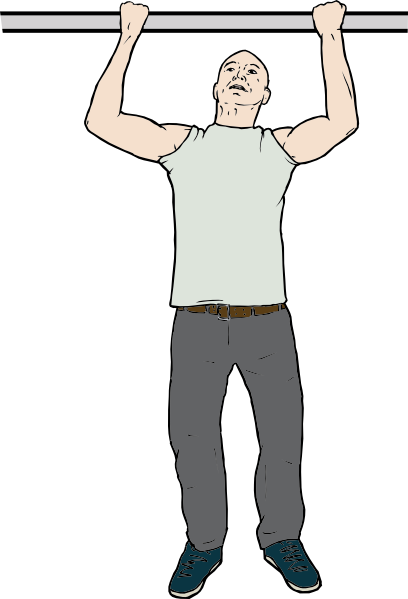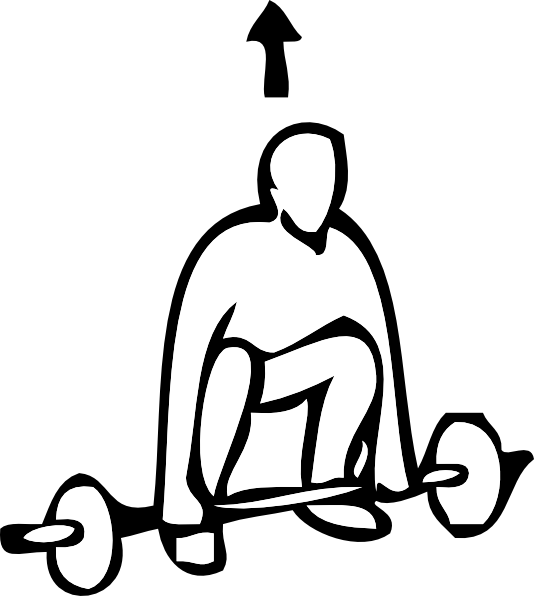[A couple of days ago] I posted that in the near future, I’ll deviate from the pragmatic reality of combat sports competition and the related training for a while and instead ponder some philosophical ideas. That’s still the plan. However, this particular issue is on my mind right now, so I don’t see a point in postponing it…
You see, sometimes, we (instructors, trainers, coaches, …) don’t practice what we preach. Sometimes, we just lack the motivation and/or dedication to fully commit to our own principles and instructions. That’s why top-level athletes can still learn from their trainers. While the latter possess a superior level of knowledge, it is the former who actually put that knowledge to good use, train hard and compete. There’s a gazillion reasons why someone might choose not to devote his life to hard training and proper nutrition at 100%. Amongst others, that’s family (a luxury many top-level athletes just can’t afford), past injuries, athletic burn-out (in the sense that you’ve been there, done that, bought the t-shirt… and decided you just want to go there again), etc, etc…
Then again, there’s the case when it absolutely makes sense for an instructor to train differently than the athletes he coaches. Here’s where we hit the topic I want to address here. In my [Complete Conditioning] classes, I have my athletes do a lot of [density training] (DT) for functional hypertrophy. Personally, I haven’t done that type of training for quite some time, though. This is not because I don’t believe in DT – it’s just that I didn’t feel it is appropriate for me. At my Dojo, I offer conditioning classes twice a week. On the other hand, I myself hit the gym three to four times a week – that is, additionally to practicing martial arts (almost) every day. Maximizing volume on each session just takes too high a toll in terms of recovery – that’s also why I advise my fighters to abstain from or at least take it easy in the conditioning classes prior to a fight. Apart from recovery, I suffer from what most would consider a luxury problem – I put on muscle mass way too fast. For most people, putting on some mass is a good idea for various reasons (which I’ll not go into here). However, if you’re competing in a weight-class regulated sport, you have to stay as light (while at the same time being as strong) as possible. Maybe not “have to”, but most choose to do so, anyways…
Hence, while I always believed in the effect of DT, I avoided it in my own S&C routine. Up until recently. You see, for quite some time now, I’ve been suffering from a bad shoulder. This doesn’t keep me from training – it just forces me to reconsider some things I’ve been doing. At this moment, this means no pressing whatsoever, regardless of the plane. Also, while I totally advocate and propone the O-lifts, right now, I just can’t bear the awkward positions they put my shoulders in. Summed up, the above circumstances pretty much leave me with deadlifts and pull-up (which I can do, oddly enough). I don’t have any fights scheduled in the nearest future, so bodyweight isn’t that much of an issue. Lastly, I‘ll finally be taking my black-belt exams in September, so I need to improve my pull-up numbers (amongst other things, a minimum of 15 pull-ups are a grading criteria). Now I’ve been stuck at 12 pull-ups for quite some time, despite doing a lot of them. I tried a GTG approach, HFT, weighted pull-up ladders, etc… and still never hit more than 12 reps. [Elias], who also needs to improve in that area, told me he was following a rather simple approach:
If some is good, a lot must be better, right? Well, at least that’s the approach I’m currently taking to pull-ups. Doing five sets per session is nice, but then again, doing 15 sets is even nicer. Somewhere along the line, I read a surprisingly simple training tip: Put your most important exercise at both the beginning and the end of your workout. This will give you twice the opportunity to improve. Guess it doesn’t take a genius to take this idea even further: I now place pull-ups at the beginning, in the middle and finally at the end of my workouts. Each series consists of sets of 6 (or less) with 40 seconds rest in between sets. For example, today I did the following:
That’s 80 pull-ups and 29 deadlifts at moderate-to-high intensity in just about 25 minutes. Now we’re talking density, right? In case you wonder, I missed one deadlift because of lacking grip strength. Then again, at that point in time, I have already done 10 sets of pull-ups and 5 sets of deadlifts…
This concept can be taken even further. Usually, I don’t do “cardio”… I just hate sitting on a stationary bike. Also, I don’t believe it really offers a benefit to fighters. I’d rather hit the heavy bag or [go Viking]… After all, running, biking and similar activities are great if you’re preparing to get away from fights… that’s just not what a fighter should do. Anyhow, next Friday, I have an endurance test coming up. I need to pass that one in order to take the trainer course at the [BSPA] (the national sports academy here. They’re the only guys who can officially certify instructors and trainers). Although I strongly believe it’s a bad idea to assess fitness by exclusively testing endurance (what makes it even worse is the fact that “endurance” is a broad term… cycling is just another, highly specialized sport, one that I just don’t play), I really have no other choice than suck it up and prepare for that stupid test. Still, I just can’t talk myself into doing a straight our of boring, wimpy, steady-state cardio. Hence, I just applied the idea of placing your important stuff (i.e., pull-ups) at the beginning, in the middle and at the end of every workout. Yesterday, this resulted in the following workout:
This type of training allows for higher intensities at the cardio part (you can see I was ramping up intensity until I reached a workload of 3.5 W per kilo of bodyweight – this happens to be the exact protocol I have to follow at the test. Only difference is I’ll have an EKG taken there… can’t do that on my own). Now [Schmidtbleicher] advises against doing endurance training immediately after a strength session. However, my endurance training is limited to the lower extremity (i.e., legs), while my strength/hypertrophy workout affects my upper back and arms. Therefore, concurring adaptation responses shouldn’t be an issue.
If you're training at my Dojo, chances are you've already got some experience with density training. If not, why not take a look at [EDT] or something similar, if only to mix things up from time to time? Looking forward to reading about your experiences with DT here!
So long,
take care
You see, sometimes, we (instructors, trainers, coaches, …) don’t practice what we preach. Sometimes, we just lack the motivation and/or dedication to fully commit to our own principles and instructions. That’s why top-level athletes can still learn from their trainers. While the latter possess a superior level of knowledge, it is the former who actually put that knowledge to good use, train hard and compete. There’s a gazillion reasons why someone might choose not to devote his life to hard training and proper nutrition at 100%. Amongst others, that’s family (a luxury many top-level athletes just can’t afford), past injuries, athletic burn-out (in the sense that you’ve been there, done that, bought the t-shirt… and decided you just want to go there again), etc, etc…
Then again, there’s the case when it absolutely makes sense for an instructor to train differently than the athletes he coaches. Here’s where we hit the topic I want to address here. In my [Complete Conditioning] classes, I have my athletes do a lot of [density training] (DT) for functional hypertrophy. Personally, I haven’t done that type of training for quite some time, though. This is not because I don’t believe in DT – it’s just that I didn’t feel it is appropriate for me. At my Dojo, I offer conditioning classes twice a week. On the other hand, I myself hit the gym three to four times a week – that is, additionally to practicing martial arts (almost) every day. Maximizing volume on each session just takes too high a toll in terms of recovery – that’s also why I advise my fighters to abstain from or at least take it easy in the conditioning classes prior to a fight. Apart from recovery, I suffer from what most would consider a luxury problem – I put on muscle mass way too fast. For most people, putting on some mass is a good idea for various reasons (which I’ll not go into here). However, if you’re competing in a weight-class regulated sport, you have to stay as light (while at the same time being as strong) as possible. Maybe not “have to”, but most choose to do so, anyways…
Hence, while I always believed in the effect of DT, I avoided it in my own S&C routine. Up until recently. You see, for quite some time now, I’ve been suffering from a bad shoulder. This doesn’t keep me from training – it just forces me to reconsider some things I’ve been doing. At this moment, this means no pressing whatsoever, regardless of the plane. Also, while I totally advocate and propone the O-lifts, right now, I just can’t bear the awkward positions they put my shoulders in. Summed up, the above circumstances pretty much leave me with deadlifts and pull-up (which I can do, oddly enough). I don’t have any fights scheduled in the nearest future, so bodyweight isn’t that much of an issue. Lastly, I‘ll finally be taking my black-belt exams in September, so I need to improve my pull-up numbers (amongst other things, a minimum of 15 pull-ups are a grading criteria). Now I’ve been stuck at 12 pull-ups for quite some time, despite doing a lot of them. I tried a GTG approach, HFT, weighted pull-up ladders, etc… and still never hit more than 12 reps. [Elias], who also needs to improve in that area, told me he was following a rather simple approach:
- Test the maximal number of pull-ups you can do
- Perform a set of 50% of the result of (1)
- Rest X seconds, where X begins at, say, 2 minutes and is decreased by 5 seconds after every workout
- Repeat 5 times

If some is good, a lot must be better, right? Well, at least that’s the approach I’m currently taking to pull-ups. Doing five sets per session is nice, but then again, doing 15 sets is even nicer. Somewhere along the line, I read a surprisingly simple training tip: Put your most important exercise at both the beginning and the end of your workout. This will give you twice the opportunity to improve. Guess it doesn’t take a genius to take this idea even further: I now place pull-ups at the beginning, in the middle and finally at the end of my workouts. Each series consists of sets of 6 (or less) with 40 seconds rest in between sets. For example, today I did the following:
Exercise
|
Weight
|
Reps
|
Rest
|
Bodyweight
|
6
|
40 sec
| |
Bodyweight
|
6
|
40 sec
| |
Pull-Ups
|
Bodyweight
|
6
|
40 sec
|
Bodyweight
|
6
|
40 sec
| |
Bodyweight
|
6
|
40 sec
| |
100 kg
|
3
|
40 sec
| |
100 kg
|
3
|
40 sec
| |
Deadlift
|
120 kg
|
3
|
40 sec
|
120 kg
|
3
|
40 sec
| |
140 kg
|
3
|
40 sec
| |
Bodyweight
|
6
|
40 sec
| |
Bodyweight
|
6
|
40 sec
| |
Pull-Ups
|
Bodyweight
|
5
|
40 sec
|
Bodyweight
|
4
|
40 sec
| |
Bodyweight
|
4
|
40 sec
| |
140 kg
|
2
|
40 sec
| |
120 kg
|
3
|
40 sec
| |
Deadlift
|
120 kg
|
3
|
40 sec
|
100 kg
|
3
|
40 sec
| |
100 kg
|
3
|
40 sec
| |
Bodyweight
|
6
|
40 sec
| |
Bodyweight
|
6
|
40 sec
| |
Pull-Ups
|
Bodyweight
|
6
|
40 sec
|
Bodyweight
|
4
|
40 sec
| |
Bodyweight
|
3
|
40 sec
|
That’s 80 pull-ups and 29 deadlifts at moderate-to-high intensity in just about 25 minutes. Now we’re talking density, right? In case you wonder, I missed one deadlift because of lacking grip strength. Then again, at that point in time, I have already done 10 sets of pull-ups and 5 sets of deadlifts…
This concept can be taken even further. Usually, I don’t do “cardio”… I just hate sitting on a stationary bike. Also, I don’t believe it really offers a benefit to fighters. I’d rather hit the heavy bag or [go Viking]… After all, running, biking and similar activities are great if you’re preparing to get away from fights… that’s just not what a fighter should do. Anyhow, next Friday, I have an endurance test coming up. I need to pass that one in order to take the trainer course at the [BSPA] (the national sports academy here. They’re the only guys who can officially certify instructors and trainers). Although I strongly believe it’s a bad idea to assess fitness by exclusively testing endurance (what makes it even worse is the fact that “endurance” is a broad term… cycling is just another, highly specialized sport, one that I just don’t play), I really have no other choice than suck it up and prepare for that stupid test. Still, I just can’t talk myself into doing a straight our of boring, wimpy, steady-state cardio. Hence, I just applied the idea of placing your important stuff (i.e., pull-ups) at the beginning, in the middle and at the end of every workout. Yesterday, this resulted in the following workout:
Exercise
|
Weight / Resistance
|
Reps / Duration
|
Rest
|
Bodyweight
|
6
|
40 sec
| |
Bodyweight
|
6
|
40 sec
| |
Pull-Ups
|
Bodyweight
|
6
|
40 sec
|
Bodyweight
|
6
|
40 sec
| |
Bodyweight
|
6
|
40 sec
| |
80 W
|
2 minutes
|
/
| |
130 W
|
2 minutes
|
/
| |
Stationary bike
|
180 W
|
2 minutes
|
/
|
230 W
|
2 minutes
|
/
| |
280 W
|
2 minutes
|
/
| |
150 W
|
5 minutes
|
/
| |
Bodyweight
|
6
|
40 sec
| |
Bodyweight
|
6
|
40 sec
| |
Pull-Ups
|
Bodyweight
|
6
|
40 sec
|
Bodyweight
|
6
|
40 sec
| |
Bodyweight
|
4
|
40 sec
| |
80 W
|
2 minutes
|
/
| |
130 W
|
2 minutes
|
/
| |
Stationary bike
|
180 W
|
2 minutes
|
/
|
230 W
|
2 minutes
|
/
| |
280 W
|
2 minutes
|
/
| |
150 W
|
5 minutes
|
/
| |
Bodyweight
|
6
|
40 sec
| |
Bodyweight
|
6
|
40 sec
| |
Pull-Ups
|
Bodyweight
|
6
|
40 sec
|
Bodyweight
|
4
|
40 sec
|
This type of training allows for higher intensities at the cardio part (you can see I was ramping up intensity until I reached a workload of 3.5 W per kilo of bodyweight – this happens to be the exact protocol I have to follow at the test. Only difference is I’ll have an EKG taken there… can’t do that on my own). Now [Schmidtbleicher] advises against doing endurance training immediately after a strength session. However, my endurance training is limited to the lower extremity (i.e., legs), while my strength/hypertrophy workout affects my upper back and arms. Therefore, concurring adaptation responses shouldn’t be an issue.
If you're training at my Dojo, chances are you've already got some experience with density training. If not, why not take a look at [EDT] or something similar, if only to mix things up from time to time? Looking forward to reading about your experiences with DT here!
So long,
take care


Kommentare
Kommentar veröffentlichen